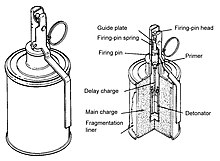| RG-42 grenade | |
|---|---|
 | |
| Type | Hand grenade |
| Place of origin | Soviet Union |
| Service history | |
| Used by | see Users |
| Wars | World War II, Continuation War,[1] Korean War, Vietnam War, Soviet-Afghan War, Gulf War, Georgian Civil War, First Chechen War, Afghan Civil War (1992–1996), Insurgency in the North Caucasus, Russo-Ukrainian War |
| Production history | |
| Designer | S. G. Korshunov[2] |
| Designed | c. 1942 |
| Produced | 1942–1954 |
| Specifications | |
| Mass | 420 grams (15 oz)[2] |
| Height | 121 millimetres (4.8 in) |
| Diameter | 54 millimetres (2.1 in) |
| Filling | TNT |
| Filling weight | 110–120 grams (3.9–4.2 oz) |
Detonation mechanism | Time-fuze, 3.2–4.0 (3.2-4.2) seconds[2] |
The Soviet RG-42 (Ручная Граната образца 42 года > Ruchnaya Granata obraztsa 42 goda, "Hand Grenade pattern of [19]42 year") was a fragmentation grenade designed by S. G. Korshunov.
While it was introduced as a stopgap measure to replace the complex and expensive RGD-33 grenade, it remained in use with the Soviet Union, Warsaw Pact countries, and allied nations such as People's Republic of China after World War II. In Soviet service it was used until 1981 during the Soviet-Afghan war.
- ^ Campbell 2020, p. 16.
- ^ a b c П. А. Гусак, А. М. Рогачев. Начальная военная подготовка (справочное пособие военрука). 2-е изд., доп. и перераб. Минск, 1975. стр.223–225